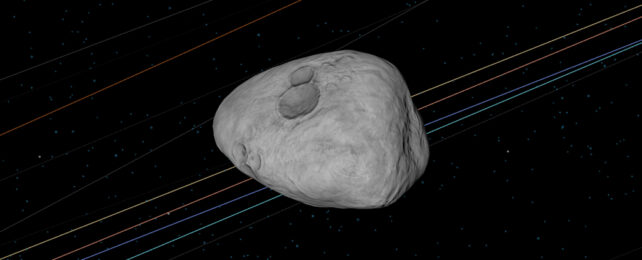According to the experts, a newly spotted asteroid called 2023 DW is one to keep an eye on. The rock, with a diameter of almost 50 meters (164 feet), has a chance of slamming into Earth on 14 February 2046.
Admittedly that chance is currently rated as "very small" by NASA and around 1 in 625 (or 0.16 percent) by ESA. You're free to interpret and respond to those odds as you wish, but we won't be moving to an underground bunker just yet.
The asteroid is ranked 1 on the Torino scale used to assess these objects, so it's only just above zero and a long way from the highest score of 10. It would need to reach a level 3 to have a 1 percent chance of localized destruction, and it's a long way from the catastrophic, human civilization-threatening certainty of a level 10.
For comparison purposes, a similar-sized asteroid caused the Tunguska event in 1908. That asteroid exploded before hitting the ground but flattened around 80 million trees across an area of 2,150 square kilometers (830 square miles). That's an area almost as big as Cape Town, though the affected region was largely unpopulated at the time.
However, comparisons are very difficult to make. The effects of any potential hit will depend on factors such as the asteroid's speed, impact angle, and the composition of the asteroid itself, which are all unknown at this point.
What we do know is that 2023 DW is some 0.14 astronomical units (AUs) away from Earth right now, the rough equivalent of 21 million kilometers or 13 million miles. It's speeding along at a velocity of 24.63 km/s (that's a steady 55,095 miles per hour).
The asteroid was discovered on February 26 and takes 271 days to go around the Sun. You can see its movements in real-time in comparison with the rest of the Solar System via the rather impressive Eyes On Asteroids tracker site from NASA.
Its name, by the way, indicates when it was discovered – starting with 2023. The "D" shows it was found in the second half of February, and then extra letters are added in order as more asteroids are added to the records.
At the moment, that tracker is showing 2023 DW missing Earth by about 1.8 million kilometers (1.1 million miles) – hence that 1 in 625 chance – but these estimates will, of course, be refined in the years ahead.
"Often when new objects are first discovered, it takes several weeks of data to reduce the uncertainties and adequately predict their orbits years into the future," says NASA. "Orbit analysts will continue to monitor asteroid 2023 DW and update predictions as more data comes in.
It will be the job of the Planetary Defense Coordination Office to decide if and when any action needs to be taken, action that could include the deployment of the Double Asteroid Redirection Test (DART) impactor that's recently been tested.
As for the most famous asteroid hit of all time, the one that wiped out the dinosaurs, that object is thought to have been roughly 200 times bigger than 2023 DW. There's a very good chance we don't have to worry about succumbing to the same fate just yet.
